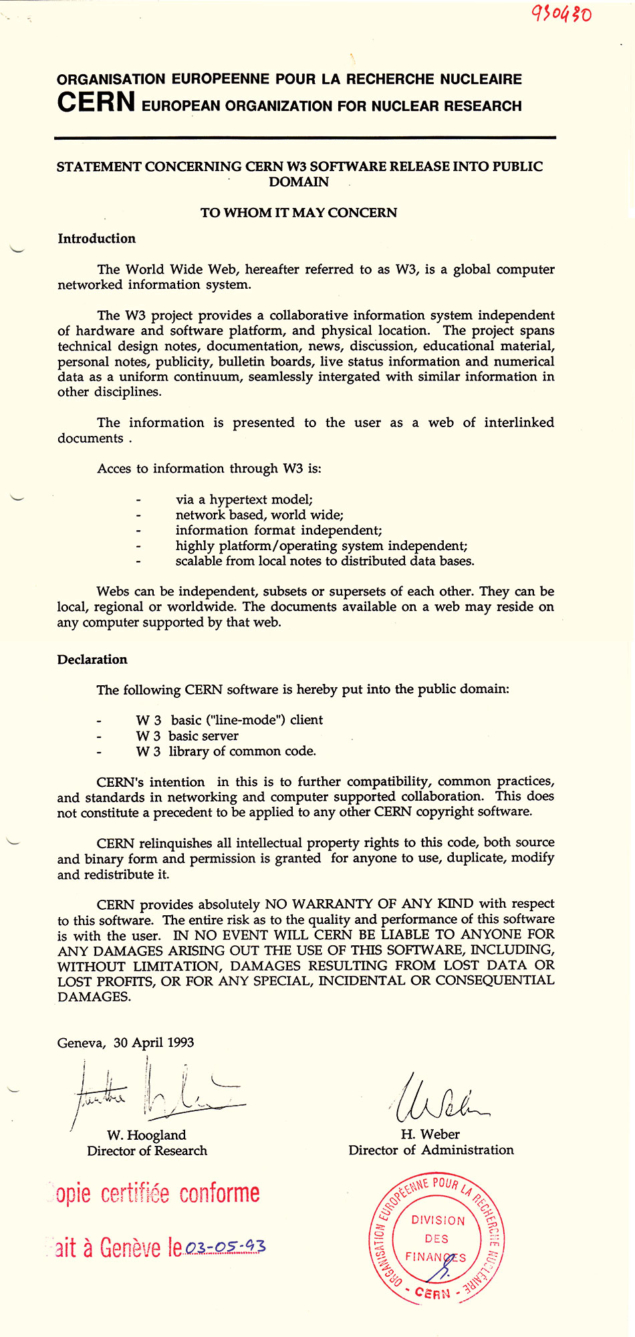The seed that led CERN to relinquish ownership of the web in 1993 was planted when the Organization formally came into being.

At a mere 30 years old, the World Wide Web already ranks as one of humankind’s most disruptive inventions. Developed at CERN in the early 1990s, it has touched practically every facet of life, impacting industry, penetrating our personal lives and transforming the way we transact. At the same time, the web is shrinking continents and erasing borders, bringing with it an array of benefits and challenges as humanity adjusts to this new technology.
This reality is apparent to all. What is less well known, but deserves recognition, is the legal dimension of the web’s history. On 30 April 1993, CERN released a memo (see image) that placed into the public domain all of the web’s underlying software: the basic client, basic server and library of common code. The document was addressed “To whom it may concern” – which would suggest the authors were not entirely sure who the target audience was. Yet, with hindsight, this line can equally be interpreted as an unintended address to humanity at large.
The legal implication was that CERN relinquished all intellectual property rights in this software. It was a deliberate decision, the intention being that a no-strings-attached release of the software would “further compatibility, common practices, and standards in networking and computer supported collaboration” – arguably modest ambitions for what turned out to be such a seismic technological step. To understand what seeded this development you need to go back to the 1950s, at a time when “software” would have been better understood as referring to clothing rather than computing.
European project
CERN was born out of the wreckage of World War II, playing a role, on the one hand, as a mechanism for reconciliation between former belligerents, while, on the other, offering European nuclear physicists the opportunity to conduct their research locally. The hope was that this would stem the “brain drain” to the US, from a Europe still recovering from the devastating effects of war.
In 1953, CERN’s future Member States agreed on the text of the organisation’s founding Convention, defining its mission as providing “for collaboration among European States in nuclear research of a pure scientific and fundamental character”. With the public acutely aware of the role that destructive nuclear technology had played during the war, the Convention additionally stipulated that CERN was to have “no concern with work for military requirements” and that the results of its work, were to be “published or otherwise made generally available”.
In the early years of CERN’s existence, the openness resulting from this requirement for transparency was essentially delivered through traditional channels, in particular through publication in scientific journals. Over time, this became the cultural norm at CERN, permeating all aspects of its work both internally and with its collaborating partners and society at large. CERN’s release of the WWW software into the public domain, arguably in itself a consequence of the openness requirement of the Convention, could be seen as a precursor to today’s web-based tools that represent further manifestations of CERN’s openness: the SCOAP3 publishing model, open-source software and hardware, and open data.
Perhaps the best measure for how ingrained openness is in CERN’s ethos as a laboratory is to ask the question: “if CERN would have known then what it knows now about the impact of the World Wide Web, would it still have made the web software available, just as it did in 1993?” We would like to suggest that, yes, our culture of openness would provoke the same response now as it did then, though no doubt a modern, open-source licensing regime would be applied.
A culture of openness
This, in turn, can be viewed as testament and credit to the wisdom of CERN’s founders, and to the CERN Convention, which remains the cornerstone of our work to this day.








